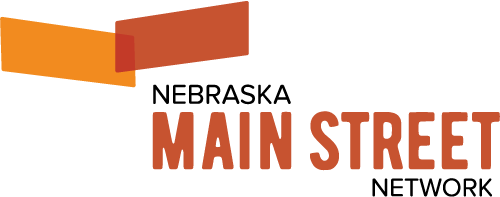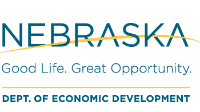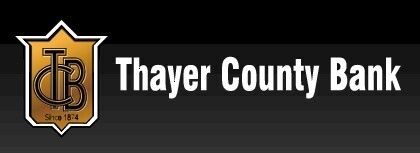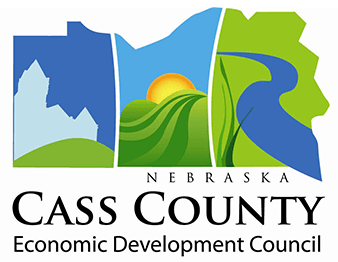Be sure to follow us on Facebook, Instagram, Twitter, and LinkedIn to learn more about the great things our Main Street and Network communities are doing to make Nebraska the Good Life!
Adaptive Reuse Project—1912 Old City Hall [Wayne]
Originally constructed as Wayne’s City Hall in 1912, the building was later renovated for use as the City’s Fire Department. After the Fire Department relocated to a new facility, the building housed a Bean Bag Chair factory for a short time. In partnership with State Nebraska Bank & Trust, the Wayne Community Theatre purchased the property to be renovated as a performance center. Lacking the funds necessary to get the performance center going, the building’s primary use became storage and the old fire truck bays were rented to generate enough income to keep the lights on. In July of 2018, Mark Kanitz & Lukas Rix negotiated the purchase of the property from State Nebraska Bank & Trust and the Wayne Community Theatre. Using funds from the City of Wayne’s LB840 Revolving Loan Fund and untold volumes of sweat equity, they cleared the space for a two-story retail homegoods store. The old fire truck bays were leased to Greg Ptacek for the development of Johnnie Byrd Brewing Company. Greg eventually purchased the truck bays in early 2020. In November 2020, when the 1912 Emporium relocated to Main Street, the original two-story building was sold to Flintless, LLC. The main floor is now the location of a new clothing boutique and there are plans to lease part of the upper-story to another business. The remaining upper-story space will be finished as a short stay apartment or as Airbnb rooms.
Interior Improvement Commercial—Swan’s for Men [Wayne]
Constructed in 1915 as a jewelry store, the historic Mine’s Jewelry building is only 24 feet wide and 43 feet deep, making it the shortest building on Main Street. Having been restored to nearly original condition in 1994, many of the original exterior fixtures are still intact, including cast-iron perimeter rails on either side of the storefront. By 2016, Jen & Chad Claussen, owners of Swan’s Apparel, had expanded their women’s clothing business to include clothing for men. As the men’s department grew, they knew they would need more space. When the Mine’s Jewelry building across the street became available, they purchased it from the previous owner and quickly gave it a new life as a men’s clothing store. After a thorough cleaning that included clearing out years of accumulation from the basement and pulling down the vines that had overgrown the rear entrance. The façade trim was repaired and repainted, and a new awning was installed. Attacking the inside, Chad and his father built the custom cabinetry and displays giving the new store a ‘manly’ backdrop for the clothing and accessories sold there. Some vintage items were retained through both restorations including a wooden railing and a large jeweler’s safe. The Claussen’s invested many hours of sweat equity in the interior improvements and opened Swan’s for Men in November of 2017.
Public Improvement Project—Illuminated City Mural [Wayne]
In 2019, Cale Geise, Mayor of the City of Wayne, declared public art a priority, which culminated in the painting of a building-length mural on the north side of the Majestic Theatre in 2020. “It’s all about creating a place as a community,” according to Giese, a 32-year-old Wayne-native who was inspired to increase the City’s public art presence after attending a presentation about how smaller cities can duplicate the atmosphere of big-city neighborhoods to retain graduates from Wayne Community Schools and Wayne State College, and to attract new residents. After reviewing submissions from 15 artists who answered the call for proposals, the City of Wayne commissioned artist, David Loewenstein of Lawrence, KS, to create a unique mural to span the entire exposed side of the Majestic Movie Theatre building at 310 Main Street. The brick building was in good condition and required minimum preparation for the art. The entire space was first primed in black, then using a projected image, the design was sketched out. The artist then moved across the space filling in the final colors. Unfortunately, Loewenstein was not able to involve community members for the Wayne mural as originally planned due to the Covid-19 pandemic. However, by listening to stories from area residents, the artist was able to reflect what was in people’s hearts and on their minds. Despite rainy weather, The Illuminated City was revealed in its completed state at an Open House on September 8, 2020. City Administrator Wes Blecke shared with the crowd how the project came to be and then introduced Lowenstein, who talked about his visits to Wayne and the inspiration for the design that was painted over the summer. The artist’s design celebrates the look and feel of movie marquees and illuminated signs inspired by the Majestic Theatre. His vision was to adapt these iconic forms glowing above the town’s skyline to represent different aspects of Wayne, including history, culture and community pride, adding references to the Wayne Chicken Show, AquaPop, the Wayne County Fair, Wayne State College and Providence Medical Center. In addition, this illuminated skyline has a backdrop of constellations inspired by the Fred G. Dale Planetarium at Wayne State College, symbolizing history, home and the future. In the months since the completion of the mural, it has become the backdrop for promotional materials and a growing number of photo ops. For 2020, the City of Wayne established a budget for public art projects. For 2021, the City of Wayne has continued their commitment to public art by earmarking more funding in the budget. In cooperation with WAED, the City solicited artwork to comprise the inaugural Wayne Sculpture Walk. A total of 10 artworks were selected for the outdoor display, which opened on May 1, 2021.
Volunteer of the Year—Mike Powicki [Wayne]
Mike Powicki is in his ninth year as the Director of Athletics at Wayne State College. Mike has served on the Revitalize Wayne (RW) Committee for nearly 8 years and has been twice-elected to serve as the RW Representative to the WAED Board of Directors. In 2020, Mike was elected WAED Board President and helped guide WAED through the Covid-19 pandemic. In 2021, he was elected to a second WAED Board President term. Mike’s interest in downtown Wayne stems from his work with students, particularly student athletes. His position is that a vibrant downtown is an important part of student recruitment for Wayne State College. Strong student recruitment and enrollment ensures the viability of myriad businesses and helps retain jobs in the Wayne area. The long-term goal is to instill a life-long love of Wayne that encourages students to either become Wayne residents or to give back to the area through their time, talents, and philanthropy. Through 2020, when so much had been disrupted, Mike pushed for a more energized RW Committee. In the fall, two socials were organized to bring together businesses representing the Retail, Hospitality & Tourism Industries to give them a voice on what they saw as positive outcomes from the pandemic and what support they needed as we moved forward. Mike helped the WAED Team sort through all of the businesses suggestions and has helped mold a refreshed look and approach to the RW Committee. While the work is not done, Mike has continued to listen and pursue a rebrand that will benefit the RW Committee and the overall Retail, Hospitality & Tourism landscape in Wayne. As the WAED Board President, Mike has challenged the WAED Team to find more ways to provide members and patrons a tangible return on their investments in WAED. He has taken an active role in mentoring the WAED Executive Director and improving WAED’s standing in the Wayne community. In response to the pandemic, Mike helped implement a Covid-specific Micro-Loan Program, supported loan repayment flexibility for area RLF Programs, lobbied for additional RLF Program funding, and kept WAED’s focus on serving Wayne’s business owner/operators through highs and lows of the pandemic.
Business of the Year—Johnnie Byrd Brewing Company [Wayne]
Johnnie Byrd Brewing Company is Nebraska’s first Benefit Corporation (B-Corp) Brewery and only the fifth B-Corp in the State of Nebraska. The company has made a vow to honor certain tenets and hold those core values equivalent to profits, as well as to prepare a benefit report annually. Johnnie Byrd Brewing’s three tenets are: 1) Fair and honest wages for employees; 2) All beers will be brewed with 100% renewable energy or will be backed by Renewable Energy Credits (RECs); and 3) 10% of annual profits will be reinvested in rural Nebraska and at least half of that investment will be directed by their employees. Over the summer of 2017, Greg & Kelly Ptacek leased the storage bay addition to the 1912 City Hall Building and quickly converted the space to house a three barrel brew house and tap room. Since opening the doors, Greg, Kelly and Johnnie Byrd Brewing Co. have hosted musicians, community theatre productions, trivia nights, community meetings, candidate forums and a variety of other events, both indoors, outdoors and on the shaded patio. They regularly bring entertainers and food trucks to downtown Wayne to enhance the visiting- or local-patron experience. In 2020, Greg & Kelly created the Byrd House, a mini food pantry to help those who might need a boost. Locals are encouraged to leave what they can to help food-insecure families. Donations of food, paper goods, toiletries and funds are all collected at the Brewery Tap Room so they can restock the pantry as needed.
Communications, Marketing & Image Development—I Love Tekamah! [Tekamah]
The I Love Tekamah! video was created to showcase Tekamah, and announce the creation of a new chamber of commerce website. The board believed very strongly in the potential of Tekamah, and the importance of telling their story to drive civic pride! The video had 23,000+ views on Facebook, and numerous positive comments. This feel-good project made people smile and reminded everyone of why they love the community.
Covid-19 Response & Recovery Project—Tekamah-Herman School Meal Program [Tekamah]
The Tekamah Herman School Meal Program was started in response to the school moving all in-person classes to online for the remainder of the school year. The same day the school announced their plans, three Tekamah residents/business owners/volunteers launched a plan to help feed students when school breakfasts and lunches would no longer be available because of the shut-down. The plan was to utilize Chatterbox Brews, as the location to prepare and serve meals. The Chatterbox collaborated with The Tekamah Area Food Pantry to plan menus, obtain food and supplies, and organize special events while a team of volunteers from the Tekamah Herman School District prepared and served two hot meals a day for what turned into 9-week program-resulting in over 1,100 volunteer hours. Over the course of 9 weeks, the School Lunch Task Force served a total of 8,327 Meals-averaging close to 200 meals per day. This effort made a huge difference for the community and shows what people can do when the need arises.
Business of the Year—Tekamah Works [Tekamah]
Tekamah’s business of the year is Tekamah Works. Tekamah Works is a shared work space that opened in place of a closed hardware store. Darl and Sarah Beck, along with Steve Cass had the idea for Tekamah Works in mind before COVID hit early last year. When the pandemic really took hold of our country and millions of people were forced to work remotely, the Beck's realized that putting their plan in place sooner rather than later could be key for Tekamah. With Tekamah situated less than 50 miles from both Omaha to the south and Sioux City to the north, the opportunity for people to work remotely but within easy access to population centers made Tekamah a very attractive location. Tekamah Works brings a new type of business model to town opening the door for entrepreneurs, small business owners, travelers, and remote workers to occupy a space on main street. While this type of space is common in bigger cities, it's not often found in rural areas. Tekamah Works is exactly the type of business that will not only provide a locals with a state of the art alternative to a home office but is also a forward thinking entity that will draw new people to town.
Volunteer of the Year—Patty Olson [Tekamah]
In a year of COVID restrictions, social distancing, businesses closing, and people out of work, it has been more important than ever to take care of those less fortunate in our communities. No one does that better than Patty Olson. For more than 15 years, Patty has been the director of the Tekamah Area Food Pantry. She also works with the school to run the backpack program. In 2020, Patty’s role as director took on a whole new challenge. For the past 5 years, the Tekamah Food Pantry had been looking for a new home, and in 2019 the organization caught a huge break and was gifted a building when the local health clinic moved into a new building. The new food pantry had tons of potential and offered the space for the dream of a thrift store in addition to the traditional food pantry. The building needed a lot of work including a new roof. Patty worked diligently to not only find contractors and volunteers to do the work but also the funding to pay for it. The new Tekamah Food Pantry and Helping Hands Thrift Store opened their doors in September of 2020. The thrift store helps pay for the food that the pantry needs, and people in need are able to get clothes and household goods at very reasonable prices right here in Tekamah! She was also an integral part of the Tekamah-Herman School Meal Program. Patty’s compassion and dedication to the people of Tekamah is nothing short of admirable. She makes Tekamah stronger!
Nebraska Main Street Network’s Inaugural President’s Award—Pure Nebraska
This is a very special award, our first President’s Award for service to the Nebraska Main Street Network and our Network Communities. We created this award to recognize those within and outside of the Network for their efforts at advocacy and service in helping our communities grow and prosper. Downtown revitalization is not an easy thing to do. It takes teamwork and collaboration as well as a lot of time, effort, and sometimes failure. Resilient communities continue to fight their way to success and don’t give up. There are many exceptional people out there who have shared their time and talents to help our communities over the past 27-years and this award exists to recognize those efforts. The inaugural President’s Award goes to Jon and Taryn Vanderford of Pure Nebraska. Pure Nebraska has been sharing the stories of communities, businesses, and the people of greater Nebraska since 2012. Many Main Street communities past and present; from the NW corner to the SE, and from the NE corner to the SW, have been featured on the program over the years. Through broadcast media, Jon and Taryn have helped increase the visibility of these places through story, enhancing the community’s ability to draw visitors and consumers. They’ve opened the eyes of many Nebraskans who never knew of all the great things going on in our own backyards. Our hidden treasures are hiding no more! Their genuine enthusiasm for the people, the places and the stories they tell show the best of what Nebraska has to offer. Congratulations and thank you for all the work you do to support Nebraska’s people and places!
Public Partner Award—Downtown Fremont BID #1 [Fremont]
The Downtown Fremont BID #1 was established to build working partnership, encourage investment and support initiatives for a healthier commercial district in downtown Fremont in 2016. The BID is operated by an all-volunteer board made up of downtown building and business owners, appointed by the Mayor of Fremont and approved by the Fremont City Council. Over the 5 years of this BID, building owners have recognized an increase in property values, therefore lowering their levy valuations. The BID has supported MainStreet of Fremont with funding to increase Christmas wreathes, bows, and garland, addition of 30 flower baskets and brackets, 3 new bike racks, new American flags and brackets, and banners for the light poles. Additionally, the BID helps MainStreet by supplementing the organization $5,000.00 in funding. The BID has also created and developed marketing videos featured on multiple social media outlets (Twitter, Instagram, and Facebook) and were also featured on television stations in Omaha. The BID continues to work in conjunction with the MainStreet Economic Vitality Committee with future projects and plans, as well as the Design Committee focusing on the historic significance of our downtown. We greatly appreciate the support of the City of Fremont – BID #1 and their efforts to continue to improve downtown Fremont.
Covid-19 Response & Recovery Project—4th Quarter Main Street Plan [Fremont]
MainStreet of Fremont, in partnership with the Fremont & Dodge County CVB, Fremont Area Chamber of Commerce and the Nebraska Main Street Network engaged area residents and consumers navigating the ongoing Covid-19 pandemic in the fall of 2020. A survey was created and distributed to consumers and business owners to gather data on shopping, dining and utilizing service-based businesses in Fremont vs. online shopping options. The goal was to assist the community in adapting to evolving needs. The consumer surveys collected guided the “Stronger Together Task Force”. This local task force focused on assisting businesses with economic recovery plans and targeted strategies that would allow consumers to buy local in a safe and comfortable environment. Local businesses began to understand consumer concerns, issues, and expectations with regard to the pandemic. The task force assisted local businesses not only to conduct business thoughtfully and respectfully, but to grow and thrive in a way that supports local consumers wants and needs. From these surveys, our Stronger Together Task Force put a plan in place to provide all MainStreet of Fremont Retail and Service Businesses in the Downtown a standing hand sanitizing station, gallons of hand sanitizer, and unlimited disposable masks for their employees and customers. In mid-November, 2020, the sanitizing stations were delivered to each of the downtown businesses that had requested them at no cost to them. This program was well received and helped MainStreet of Fremont and businesses prepare and launch the annual Christmas Walk event held on Small Business Saturday.
Façade Improvement—ESU #8 [Neligh]
A local landmark and anchoring Old Mill District Main Street business, ESU #8, had the opportunity to move from the district a construct a brand-new facility but instead chose to remodel and restore the 1901 building that they were already located in thanks to the leadership of Bill Mowinkel. The $4.38 million renovation is a stunning improvement and incorporates the Neligh Mill Historic red. Inside, the building boasts refinished 120-year-old fir wood floors and original tin ceilings. Community members urged the ESU to retain as many historic elements as possible. The improvements were sensitive to the historic character of the building while accommodating modern office and technology updates. The building also utilizes the 12,000 square-foot space more efficiently. “With strategic planning and foresight, directors directed money into a rainy-day fund for capital improvements, dreaming of what the future would look like. The end result is a renovated and modernized facility located at the corner of Main and Third streets, that maintains historic significance as a cornerstone of downtown Neligh.” according to a quote in Antelope County News, March 15, 2019. With foresight of previous administration and former board members, the major renovations were not funded by a bond. With a vision and a fund started more than 20 financed the massive project. Funds were generated in the early years of the ESU and through good investments, the funds accumulated interest and flourished. Because of this wise foresight, the facility is debt and bond free. Originally, consideration to move the ESU outside the community to buy land a build was discussed. The ESU board did not want to do that. It would have emptied a large portion of downtown Neligh. Also important to the project was using contractors and sub-contractors from the area, keeping jobs local and benefitting small businesses throughout the counties the ESU serves. Improvements to other buildings in downtown Neligh were spinoffs from the work done on the ESU building. We like to say this is the domino effect that we see in a lot of communities. Kudos to Lauren and her team past and present for their work in helping guide these projects along. It’s a lot of work and not easy. Not only does the Nebraska Main Street Network recognize this as a model façade improvement project, but more importantly this is a project representative of what the Main Street program stands for, investing in downtown vitality. Communities are like the human body. There are many parts needed to stay alive with the heart being the most important. Downtown is the heart of Neligh and what the ESU has done here is keeping the community alive and vibrant for years to come.
Business of the Year—The Cedar Room [North Platte]
The Cedar Room is American Fusion Fine Dining at its best coupled with a beautiful bar serving unique cocktails. Owners Hector Ortiz and BJ Stenger transformed the historic Hinman building inside and out. The attention to detail on the inside makes this restaurant second to none. The building had been abandoned for many years and was such an eye sore to our downtown. Not to be outdone by the atmosphere, the food is unique, delectable and fills a void in what North Platte was missing. The owners can be found there every night serving food and drinks, visiting with patrons and making sure everything runs smoothly. We appreciate Hector & BJ for bring their vision to life in beautiful downtown North Platte and grateful for the nightlife they created as well as the visual enhancements to the area.
Volunteer of the Year—Downtown North Platte Board of Directors [North Platte]
In 1972, canopies were placed over the sidewalks of the Downtown North Platte main corridor to give it a "mall" feel. Fast forward to 2108 and the canopies were removed to make way for a more vibrant downtown. The Board of Directors knew they could not wait around for the City to improve the area, so they took matters into their own hands. They were facing a city administrator ready to retire, new blood coming in and a very small budget. It was decided that the city would repair the sewer as well as other street and below issues leaving the downtown board to make a plan for the streetscape. They asked the community to give input on their wish list of things they would like to see happen downtown. Businesses started changing their facades and adding their own awnings. The downtown board worked with the City of North Platte to secure a $500,000 grant from the Quality Growth Fund. That money was used to purchase benches, planters, bike racks, trash receptacles, ash receptacles, festoon lighting, archways, trees and flowers. The board worked with City officials on the various details of the project and helped oversee some of the bigger projects such as the installation of the 2 archways. While downtown is still a work in progress, the leadership of the downtown association board that made this project happen. They are passionate about downtown and don’t take no for an answer. Occupancy is 100% along the main corridor which was only about 30% occupied 6 or 7 years ago.
Interior Improvement Commercial—Double Dips Ice Cream [North Platte]
Lori Bergman started this project in April 2019 and completed it in August 2019. She envisioned a space reminiscent of an old-fashioned ice cream parlor where people could gather with family and friends to celebrate special occasions. Lori, her two sons, and her husband did all the renovations, except plumbing and electrical. They started by taking down plaster, particle and peg board from the walls and exposing the original brick. When they took down the drop-ceiling they found most of the tin ceiling in excellent condition. They removed four layers of flooring and exposed the original wood floors. Temporary walls were removed opening the entire storefront area as a dining space. The renovation would not be complete without the unique antique cabinet Lori purchased from a country shop in Arnold Nebraska. This large cabinet had to be cut in half in order to move it from Arnold and into the building. Lori’s husband transformed the cabinet into a large ice cream bar spanning the length of the back wall. The serving and display counter were also custom built by her husband from antiques and wooden doors found in local buildings. Lori and her family have transformed a neglected downtown storefront into a destination.








